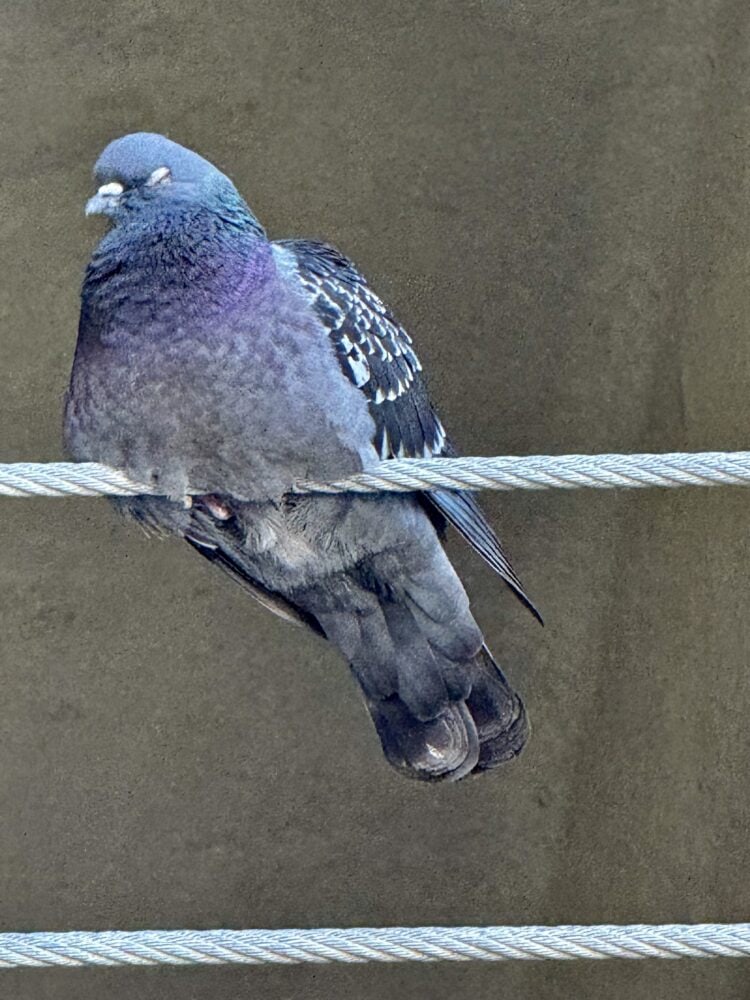Large pigeon flocks in urban areas can pose significant environmental challenges. These birds, while often seen as harmless city dwellers, can create substantial issues when their populations grow unchecked. Pigeon droppings carry health hazards, containing bacteria, viruses, and fungi that can lead to respiratory problems and other diseases in humans.
Urban environments provide pigeons with ample food sources and nesting sites, allowing their numbers to increase rapidly. This overpopulation can lead to damage to buildings, increased noise pollution, and competition with native bird species for resources. Additionally, the accumulation of pigeon waste can corrode building materials and create unsightly messes in public spaces.
Effective management of large pigeon flocks is crucial for maintaining urban environmental health. According to the Humane Society’s article, quoting: “OvoControl effectively reduces hatching rates in pigeons, thereby limiting flock sizes and diminishing problems associated with large numbers of pigeons.” This approach, along with other humane population control methods, can help mitigate the environmental impact of pigeon overpopulation while ensuring the ethical treatment of these urban birds.
Key Takeaways
- Pigeon droppings pose health risks and can damage urban infrastructure
- Unchecked pigeon populations compete with native species and create environmental issues
- Humane population control methods can effectively manage pigeon flocks in urban areas
The Environmental Concerns Related to Pigeon Overpopulation
Pigeon overpopulation in urban and rural areas leads to significant environmental issues. These problems affect ecosystems, infrastructure, and human health in various ways.
Impact on Urban Ecosystems
Large pigeon populations disrupt urban biodiversity. They compete with native bird species for food and nesting sites, often displacing them. Pigeons’ droppings corrode building materials and monuments, causing structural damage over time.
Excessive pigeon waste contaminates water sources, including ponds and fountains. This pollution harms aquatic life and creates unsanitary conditions for other animals. Pigeons also scatter garbage while foraging, contributing to litter problems in cities.
Their droppings carry pathogens that can spread to humans and other animals. This poses health risks and necessitates frequent cleaning of public spaces.
Issues in Agricultural Areas
In rural settings, pigeon overpopulation affects crop production. Large flocks consume newly sown seeds and damage young plants, reducing crop yields. This forces farmers to use more pesticides and bird deterrents, which can harm beneficial insects and other wildlife.
Pigeons roosting in barns and silos contaminate stored grains with their droppings. This leads to significant losses for farmers and increases the risk of disease transmission to livestock.
Their presence attracts predators like hawks and falcons. While this might seem positive for conservation, it can threaten farm animals, especially poultry.
Strategies for Managing Large Pigeon Flocks
Effective management of large pigeon populations requires a multi-faceted approach. Key strategies focus on modifying habitats to make them less attractive to pigeons and implementing wildlife conservation efforts that balance pigeon control with ecological considerations.
Habitat Modification and Deterrence
Altering the urban landscape can discourage pigeons from roosting and nesting. Install physical barriers like spikes or netting on ledges and rooftops to prevent pigeons from landing. Remove or cover potential food sources, such as open trash bins or scattered food waste.
Use visual deterrents like reflective tape or predator decoys to scare pigeons away. Employ sonic devices that emit distress calls or predator sounds to create an unwelcoming environment for the birds.
Modify building designs to eliminate flat surfaces where pigeons can perch. Slope ledges at a 45-degree angle or more to make them unsuitable for nesting.
Wildlife Management and Conservation Efforts
Implement humane population control methods such as contraception or egg replacement programs. These techniques help reduce pigeon numbers without harming the birds.
Educate the public about the importance of not feeding pigeons in urban areas. Create designated feeding zones away from populated areas to redirect pigeon activity.
Work with wildlife experts to develop comprehensive management plans that consider the ecological role of pigeons. Introduce natural predators like falcons in controlled settings to help regulate pigeon populations.
Monitor pigeon health and behavior to detect potential disease outbreaks early. Collaborate with veterinarians and wildlife biologists to ensure the well-being of both pigeons and other urban wildlife.
Conclusion
Large pigeon flocks pose significant environmental challenges in urban areas. Their droppings can damage buildings, spread diseases, and create unsanitary conditions. Effective management strategies include population control, habitat modification, and public education. By implementing these measures, cities can mitigate the negative impacts of pigeon overpopulation while maintaining ecological balance.



Leave a Reply